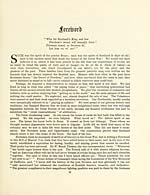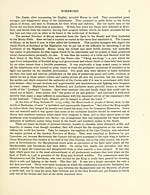Places > Morayshire roll of honour
(8) Page iv
Download files
Complete book:
Individual page:
Thumbnail gallery: Grid view | List view

iv FOREWORD
** themselves, who regarded them as foes worthy of their steel, and ranked them as the finest
" fighting unit of the British Army."
They were really the " Storm Troops " of the Allies, and it is known that in a German order
giving a list of the regiments from whom they had most to fear, the " lads with the kilts," otherwise
described as the " ladies from hell," were placed at the top ! *
This Roll of Honour is a testimony that in whatever Scotland did, the men of Moray took a
noble and a worthy part. One fact stands to their credit and undying honour and should never
be forgotten. At the time of the nation's need in the early days of the war the North of Scotland
showed a higher percentage of voluntary enlistments in proportion to population than any other
part of the United Kingdom. It is not derogatory to the great efforts of other localities to say
that the " land beyond the Grampians " topped the list. Could anyone who knows the antecedents
of the race expect anything else ? History bristles with facts about the fighting instincts of the
Highlanders. Going back to remote times, theirs was the only Province of the British Isles which
the Romans failed to conquer — unfortunately for the province, some would say. The Emperor
Severus, we are told, lost an army of 50,000 in the attempt. Shaw in his famous " History of
Moray " supplies the words of the Roman historian Tacitus as descriptive of the ancient inhabitants
• of Moray and particularly the Highlanders : — " This race possessed a sturdy frame of body, limbs
" well-knit, stern countenances and a great degree of courage. You could not so easily persuade
" them to till their lands, and observe the respective seasons of the year, as you might bring them
" to face their enemies, and give and take the most deadly wounds. For they even held it slothful
" and cowardly to acquire by the sweat of their brows, what they could possess by the shedding
" of their blood."
*It will be of great interest to place on record the following official statement, kindly supplied to me by the
War Office, showing the composition of the 51st Division during the late war as compiled from returns dated
1st July, 1917 : —
51ST (HIGHLAND) DIVISION, BRITISH ARMY IN FRANCE.
INFANTRY.
152ND Infantry Brigade.
Headquarters.
i/5th Battalion, Seaforth Highlanders.
i/6th Battalion, Seaforth Highlanders.
1 /6th Battalion, Gordon Highlanders.
i/8th Battalion, Argyll and Sutherland Highlanders.
153RD Infantry Brigade.
Headquarters.
1 /6th Battalion, Royal Highlanders.
i/7th Battalion, Royal Highlanders.
1 /5th Battalion, Gordon Highlanders.
1 /7th Battalion, Gordon Highlanders.
154TH Infantry Brigade.
Headquarters.
1 /9th Battalion, Royal Scots Regiment.
1 /4th Battalion, Seaforth Highlanders.
1 /4th Battalion, Gordon Highlanders.
i/7th Battalion, Argyll and Sutherland Highlanders.
1 /8th Battalion, Royal Scots (P.) (Divisional Troops).
DIVISIONAL TROOPS.
i/ist Headquarters of Divisional Artillery.
255th (i/ist Highland Brigade), Royal Field Artillery.
256th (i/2nd Highland Brigade), Royal Field Artillery.
51st (Highland) Divisional Ammunition Column and Sub-Park.
i/ist Headquarters, Highland Divisional Royal Engineers.
400th (Highland) Field Company, Ro3 7 al Engineers.
401st (Highland) Field Company, Royal Engineers.
404th (Highland) Field Company, Royal Engineers.
51st (Highland) Divisional Signal Company.
1 /2nd Highland Field Ambulance.
i/3rd Highland Field Ambulance.
2/ist Highland Field Ambulance.
51st (Highland) Sanitary Section.
LINES OF COMMUNICATICN.
i/ist Highland Casualty Clearing Station.
** themselves, who regarded them as foes worthy of their steel, and ranked them as the finest
" fighting unit of the British Army."
They were really the " Storm Troops " of the Allies, and it is known that in a German order
giving a list of the regiments from whom they had most to fear, the " lads with the kilts," otherwise
described as the " ladies from hell," were placed at the top ! *
This Roll of Honour is a testimony that in whatever Scotland did, the men of Moray took a
noble and a worthy part. One fact stands to their credit and undying honour and should never
be forgotten. At the time of the nation's need in the early days of the war the North of Scotland
showed a higher percentage of voluntary enlistments in proportion to population than any other
part of the United Kingdom. It is not derogatory to the great efforts of other localities to say
that the " land beyond the Grampians " topped the list. Could anyone who knows the antecedents
of the race expect anything else ? History bristles with facts about the fighting instincts of the
Highlanders. Going back to remote times, theirs was the only Province of the British Isles which
the Romans failed to conquer — unfortunately for the province, some would say. The Emperor
Severus, we are told, lost an army of 50,000 in the attempt. Shaw in his famous " History of
Moray " supplies the words of the Roman historian Tacitus as descriptive of the ancient inhabitants
• of Moray and particularly the Highlanders : — " This race possessed a sturdy frame of body, limbs
" well-knit, stern countenances and a great degree of courage. You could not so easily persuade
" them to till their lands, and observe the respective seasons of the year, as you might bring them
" to face their enemies, and give and take the most deadly wounds. For they even held it slothful
" and cowardly to acquire by the sweat of their brows, what they could possess by the shedding
" of their blood."
*It will be of great interest to place on record the following official statement, kindly supplied to me by the
War Office, showing the composition of the 51st Division during the late war as compiled from returns dated
1st July, 1917 : —
51ST (HIGHLAND) DIVISION, BRITISH ARMY IN FRANCE.
INFANTRY.
152ND Infantry Brigade.
Headquarters.
i/5th Battalion, Seaforth Highlanders.
i/6th Battalion, Seaforth Highlanders.
1 /6th Battalion, Gordon Highlanders.
i/8th Battalion, Argyll and Sutherland Highlanders.
153RD Infantry Brigade.
Headquarters.
1 /6th Battalion, Royal Highlanders.
i/7th Battalion, Royal Highlanders.
1 /5th Battalion, Gordon Highlanders.
1 /7th Battalion, Gordon Highlanders.
154TH Infantry Brigade.
Headquarters.
1 /9th Battalion, Royal Scots Regiment.
1 /4th Battalion, Seaforth Highlanders.
1 /4th Battalion, Gordon Highlanders.
i/7th Battalion, Argyll and Sutherland Highlanders.
1 /8th Battalion, Royal Scots (P.) (Divisional Troops).
DIVISIONAL TROOPS.
i/ist Headquarters of Divisional Artillery.
255th (i/ist Highland Brigade), Royal Field Artillery.
256th (i/2nd Highland Brigade), Royal Field Artillery.
51st (Highland) Divisional Ammunition Column and Sub-Park.
i/ist Headquarters, Highland Divisional Royal Engineers.
400th (Highland) Field Company, Ro3 7 al Engineers.
401st (Highland) Field Company, Royal Engineers.
404th (Highland) Field Company, Royal Engineers.
51st (Highland) Divisional Signal Company.
1 /2nd Highland Field Ambulance.
i/3rd Highland Field Ambulance.
2/ist Highland Field Ambulance.
51st (Highland) Sanitary Section.
LINES OF COMMUNICATICN.
i/ist Highland Casualty Clearing Station.
Set display mode to: Large image | Transcription
Images and transcriptions on this page, including medium image downloads, may be used under the Creative Commons Attribution 4.0 International Licence unless otherwise stated. ![]()
| Rolls of honour > Places > Morayshire roll of honour > (8) Page iv |
|---|
| Permanent URL | https://digital.nls.uk/100233708 |
|---|---|
| Description | Arranged alphabetically by first-named place, starting with Aberdeen. |
|---|

